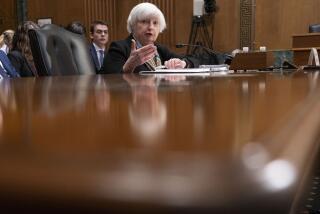Aftermath of Maryland, Ohio Crises : More S&Ls; Seeking U.S. Insurance
- Share via
WASHINGTON — Dozens of privately insured savings and loan associations in several states have applied for federal deposit insurance after a run on deposits at state-chartered Maryland thrift institutions, the nation’s top savings and loan regulator said Wednesday.
“There is a trend” toward federal protection for all savings deposits because of anxiety stimulated by the Maryland crisis earlier this month and a similar crisis last March among Ohio’s state-chartered associations, Edwin J. Gray, chairman of the Federal Home Loan Bank Board, said in an interview.
But Gray, whose agency runs the federal insurance program, stressed that it is Congress’ responsibility to decide whether all deposits should be federally insured. “That is up to Congress,” he said. “But there is a de facto trend already under way.”
Although worried depositors do not seem to be queuing up in other states to withdraw funds, Gray said dozens of state-chartered thrifts in Massachusetts, North Carolina and Pennsylvania have applied for the federal coverage that guarantees deposits up to $100,000.
Federally insured deposits are protected by a $6-billion fund--and, perhaps more importantly, by a pledge of the full faith and credit of the U.S. government, a sweeping promise that generates confidence.
“The federal eagle means a great deal,” Gray noted. He said the bank board’s examiners, reinforced by extra personnel from other federal agencies, are moving rapidly to process the new applications.
The Maryland crisis began May 9 after the disclosure of management problems caused a run on deposits at Old Court Savings & Loan in Baltimore. Hoping to stem a systemwide panic, Maryland Gov. Harry R. Hughes on May 14 imposed a $1,000-a-month limit on withdrawals from 102 state-chartered institutions.
The state Legislature, in an emergency session last weekend, quickly approved a bill requiring all Maryland savings and loans to seek federal deposit insurance; 27 have applied, with 12 being granted preliminary approval by the bank board.
The prospect of federal protection apparently has calmed the situation in Maryland, even though the insurance has not formally been put into effect. Hughes has exempted payroll and escrow accounts from the $1,000 limit at all institutions, and on Tuesday he abolished the $1,000 restriction entirely at 16 savings and loans.
Gray emphasized that not a whisper of panic has spread to any of the nation’s federally protected savings associations.
“We detect no evidence at all that (federally) insured institutions have been affected in any way” by the Maryland and Ohio situations, he said.
However, he said he is worried about possible threats to the insurance system from excessive risk-taking by imprudent savings and loan managers.
If associations are crippled by bad investments and collapse, the insurance fund would be depleted to pay off depositors.
“We are operating an insurance carrier, and we have to be concerned about the welfare of the carrier,” he said, noting that the $6 billion in the fund in effect supports $800 billion in deposits.
Gray is particularly upset with states such as California, where savings and loans are allowed virtually unlimited access to all sorts of business ventures. “What relation does fast-food restaurants, Arabian horses and oil-drilling operations have with real estate?” he asked.
Under Gray’s leadership, the bank board has imposed regulations to curb what it views as excessively rapid growth and unhealthy speculation in risky lines of business.
Some segments of the thrift industry have attacked Gray as a stodgy conservative trying to block needed diversification. But Gray insists that savings and loan managers must keep sight of their primary mission of providing money for housing.
Federal regulators “need to inject a greater sense of discipline into the thrift industry--a discipline needed for its survival,” Gray warned.
More to Read
Sign up for Essential California
The most important California stories and recommendations in your inbox every morning.
You may occasionally receive promotional content from the Los Angeles Times.










